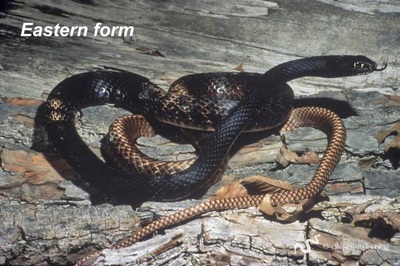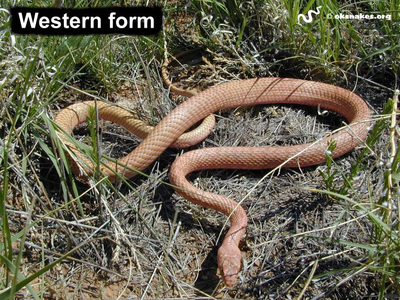Coachwhip
Masticophis flagellum testaceus
Masticophis flagellum flagellum
Masticophis flagellum testaceus
Masticophis flagellum flagellum
HARMLESS
Note: There are 2 subspecies of coachwhips in Oklahoma, the western (Masticophis flagellum testaceus), which occurs west of I-35, and the eastern (Masticophis flagellum flagellum), which occurs east of I-35. They have different colorations, so please see the description section below.
Description:
One of the longest snakes in Oklahoma, it has a variable coloration across the state. Eastern coachwhips typically have a dark (almost black) front half that fades into a reddish-brown rear end. Western coachwhips typically have a uniform color across their entire body. They can be light to dark brown to pinkish in color. The scales and coloration of the coachwhip's tail make it look like a braided rope, hence its common name. The scales are smooth and the anal plate is divided.
Juveniles have a mottled pattern and have crossbands on the front half of their body.
Size:
Adults 36 - 82 inches (91 - 208 cm)
Prey:
Rodents, snakes, lizards, and insects such as grasshoppers and cicadas
Reproduction:
Mates in spring and lays a clutch of 4 - 16 eggs in June or July. Eggs hatch 6 - 11 weeks later and babies are 12 - 16 inches (30 - 41 cm) long.
Habitat:
Dry, sandy areas, rocky hillsides, and grassland prairies.
Other Information:
This is one of the few snakes that is known to be active during the heat of the day. It is one of Oklahoma's fastest snakes and will seek safety in a tree or a mammal burrow if chased. When cornered, this snake will defend itself by striking and buzzing its tail.
It used to be believed that the coachwhip would chase down an adversary and whip him to death with his tail. Of course, this is not true.
Why doesn't the range map show this species in my county?
Note: There are 2 subspecies of coachwhips in Oklahoma, the western (Masticophis flagellum testaceus), which occurs west of I-35, and the eastern (Masticophis flagellum flagellum), which occurs east of I-35. They have different colorations, so please see the description section below.
Description:
One of the longest snakes in Oklahoma, it has a variable coloration across the state. Eastern coachwhips typically have a dark (almost black) front half that fades into a reddish-brown rear end. Western coachwhips typically have a uniform color across their entire body. They can be light to dark brown to pinkish in color. The scales and coloration of the coachwhip's tail make it look like a braided rope, hence its common name. The scales are smooth and the anal plate is divided.
Juveniles have a mottled pattern and have crossbands on the front half of their body.
Size:
Adults 36 - 82 inches (91 - 208 cm)
Prey:
Rodents, snakes, lizards, and insects such as grasshoppers and cicadas
Reproduction:
Mates in spring and lays a clutch of 4 - 16 eggs in June or July. Eggs hatch 6 - 11 weeks later and babies are 12 - 16 inches (30 - 41 cm) long.
Habitat:
Dry, sandy areas, rocky hillsides, and grassland prairies.
Other Information:
This is one of the few snakes that is known to be active during the heat of the day. It is one of Oklahoma's fastest snakes and will seek safety in a tree or a mammal burrow if chased. When cornered, this snake will defend itself by striking and buzzing its tail.
It used to be believed that the coachwhip would chase down an adversary and whip him to death with his tail. Of course, this is not true.
Why doesn't the range map show this species in my county?





